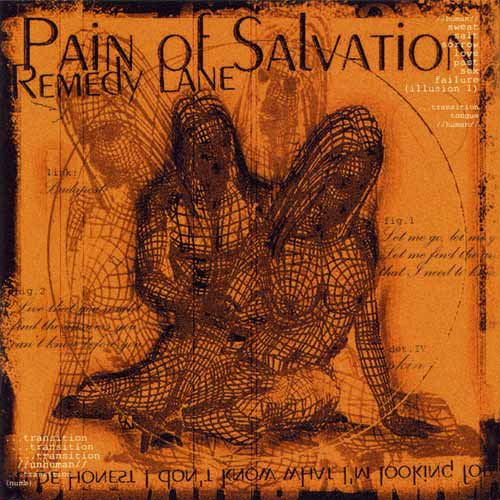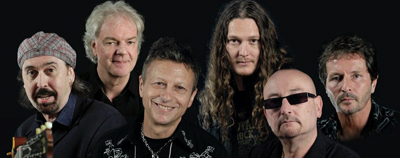Remedy Lane by Pain of Salvation (InsideOut Music 2002)
Don't find fault, find a remedy
Remedy Lane Tracklist
1. Of Two Beginnings – 2:24
Chapter I
2. Ending Theme – 4:59
3. Fandango – 5:51
4. A Trace of Blood – 8:17
5. This Heart of Mine (I Pledge) – 4:01
Chapter II:
6. Undertow – 4:47
7. Rope Ends – 7:02
8. Chain Sling – 3:58
9. Dryad of the Woods – 4:56
Chapter III:
10. Remedy Lane – 2:15
11. Waking Every God – 5:19
12. Second Love – 4:21
13. Beyond the Pale – 9:56
Concept, lyrics and music by Daniel Gildenlöw, except the instrumental
part of Rope Ends, which is by Daniel Gildenlöw and Fredrik Hermansson
Remedy Lane Lineup
Daniel Gildenlöw: Lead vocals, guitar
Fredrik Hermansson: Keyboards
Johan Hallgren: Guitar, backing vocals
Johan Langell: Drums, backing vocals
Kristoffer Gildenlöw: Bass, backing vocals
Produced by Daniel Gildenlöw and Anders 'Theo' Theander
Before buying albums by Yes, Budgie and Uriah Heep, as a young person in the seventies, I was attracted to these bands by the Roger Dean imagery displayed in the form of: album covers, posters and promotional booklets in record shops like Harleqin; advertisement graphics in music papers such as Sounds and Melody Maker; colour photographs of the band on stage, amidst their light show and dry ice and in revelatory books like the NME and Melody Maker Annuals of 1974. Experience of the actual music was very rare to the point of being almost non-existent. Yes appeared on the BBC's Sounding Out TV programme during a school summer holiday and a Radio One disc jockey once played the single version of Roundabout. It was Dean's futuristic fantasy landscapes, the bands' long hair and hippy clothing, reviews in the music press and word-of-mouth accounts of live shows from older acquaintances (usually my friends' older brothers) which made them irresistably appealing to me. It may seem ridiculous now, but I bought several albums on the strength of the album cover artwork, as displayed in the record shop bins. I was rarely, if ever, disappointed by the music. Forty years on, bands have a different approach. Gone are the hand painted fantasy images and in come modern computer inspired graphics. All the artwork, 3D animations and some of the photography for Tragedy Lane is credited to Pain of Salvation's frontman, Daniel Gildenlöw. Initially, I found the artwork unattractive . . .
I should point out at this stage, that Pain of Salvation are a band of whom I was aware, but whose music I had not heard, until this album for the purpose of this review. Reading around the subject, I learned that Pain of Salvation are a long established band from Sweden and Remedy Lane is their fourth album. Tellingly, frontman Daniel Gildenlöw, as a multi-instrumentalist, has been part of the touring lineups of progressive rock bands The Flower Kings and Transatlantic. Besides containing Roine Stolt, both bands are notable for the dexterity and complexity of their musicianship and their similarities with early progressive rock bands, such as Yes. Attributed to Pain of Salvation are labels like progressive rock and progressive metal (an irritating and unhelpful label at the best of times), so I was interested to see into which camp they fell, but fearing the worst (so-called progressive metal).
As stated earlier, I found the artwork unattractive, with dull and depressing imagery: the front cover has two vector-drawn figures, one sitting behind the other as though to implore the one in the foreground. Behind them are the same two figures reversed left to right. Around the figures is a circle with some scripted lettering, including, 'Let me go . . . ' The back cover has an illuminated vector drawing of a single figure in front of a dark, rocky landscape. Lyrics begin on the second page of content, in front of the rocky landscape, as the first has additional poetry with the ubiquitous vector figures. The pattern of lyrics and poetry, annotated with dates and locations, continues throughout the booklet.
So what about the music? Opening track Of Two Beginnings, begins with bubbling instrumentation and vocals in the style of Fish imitating Genesis-era Peter Gabriel. It is a short track, but at the halfway point, transforms itself into a Faith No More-sounding passage. Two Beginnings' position in the tracklist, preceding 3 x four-part 'chapters' makes it seem like an overture. To the Faith No More and Marillion hybrid of the 'overture' are added spoken-word vocals, rather like Mike Portnoy with Dream Theater, for second track Ending Theme (which confusingly is the first part of Chapter I). Daniel Gildenlöw is a capable singer, but adds his own dimension in an angst-ridden delivery, which is not encouraging. Fandango has an unusual time signature, consisting of spiky guitar and piano, counterpointed with gentle harmonies. A number of observers have commented on how Pain of Salvation are characterised by an 'abrupt switching between heavy and calm passages' and it is clearly evident at this early stage, along with an extremely adept musicianship. Melodic and intricate guitar parts follow with more FNM passages. Amongst the soft and harsh passages, ideas come and go seemingly at random, giving no shape or form to the album. A glimmer of light comes in the revelation that this album is reassuringly progressive.
Track four, A Trace of Blood, has an excellent driving, melodic intro, which settles into an imaginative riff, where Gildenlöw uses his voice to create a percussive sound, but the lyrics are jarring with phrases like, 'Through roads of agony,' and 'Lost the will to live.' A Trace of Blood is complex with heavy guitar and kick-drums, having elements of Dream Theatre and Flower Kings added to the aforementioned bands. The sprightly instrumentation of this track certainly made me sit up and listen. In the booklet we are shown a blurred picture of overlapping man, woman and child with indeterminate figure. Fifth track, This Heart of Mine (I PLedge), closes Chapter I by taking us back to Fish-era Marillion territory and more uncomfortable, melodramatic lyrical motifs, such as, 'I pledge to love you till I die,' although the superb solos are like Yes's Steve Howe on Relayer (Atlantic 1974).
Undertow opens Chapter II with unorthodox counterpointing piano and guitar. Eerie guitar effects, whispery vocals and echo-y drums are redolent of those on Pink Floyd's Animals (Harvest/EMI 1977), but gradally become replaced with phrasing and harmonies like Geoff Tate's for Queensryche. The booklet has two flying figures in black and white. Daniel Gildenlöw seems to be exorcising terrible anxieties through the gothic gloom of his music. Rope Ends has an accompanying picture of a vector-woman hanging by the neck and the opening line, 'Another day of emptiness.' Paradoxically, it also has a heavy choppy opening riff, which is more Dream Theater than Dream Theater and a jaunty vocal phrasing like the resurgent British beat groups of the late seventies/early eighties (Contempt, Vapours). It develops an interesting instrumental jazz-y guitar and keyboard passage at the halfway mark, so when Daniel Gildenlöw shouts, 'Go,' you get the impression he is genuinely enjoying himself. It is odd how Pain of Salvation manage to give interminably depressing material such an uplifting feel.
Chain Sling continues the upbeat vocal pattern added to psychedelic jangly guitar. A big chorus without a real hook gives it a stage musical effect. The lyrics and an additional poem in the booklet are superimposed onto an ethereal dancing girl in front of a leafy tree backdrop. As is so often the case, Gildenlöw's vocals employ Mike Patton's gestures and harmonies. Chapter II finishes with Dryad of the Woods, an incongruous, but scintillating instrumental based around acoustic guitar and synthesizer. This is supremely melodic and the time change towards the end is marvellous. Chapter III opens with another dynamic, albeit short, synthesizer-led track, Remedy Lane. Johan Langell's drums have a big sound, like Nick Mason using drumsticks on bongos. Although the tracks span different 'chapters', this is the strongest and most coherent part of the album. Waking Every God reminds me of when Manfred Mann recruited the soulful Noel McCalla to harmonise with the great Chris Thompson, and, although commercial-sounding, contains some of Daniel Gildenlöw's best vocals. Curiously, the booklet images of trees and orange nothingness are more anodyne.
Second Love is an unashamedly commercial close-harmony track, which at best could be a Patrick Swayze song, especially during, 'You came like the wind'. At worst it could be something by Nickelback, yet, strangely, the progressive elements are still here, including Genesis vocals, Mike Oldfield instrumentation and a Brian May guitar solo. Second Love represents a stroke of heroism and, in another age, may have given them a hit single. If Of Two Beginnings is an overture, Beyond the Pale is a finale. The band throw in everything but the kitchen sink and there is little point, at this stage, in naming again all the influences, but, rest assured, they are present, particularly Mike Patton's distinctive roar. The lyrics part of the booklet finishes with an out of focus tormented-looking person, while the credits have an image of some town-dwelling birds and a photograph of the band.
I began by not liking the turgid imagery or the idea that PoS could be progressive metal (whatever constitutes progressive metal), but I have to admit I warmed to Remedy Lane because of the outstanding musicianship and variety of ideas. Nevertheless, Remedy Lane lacks a certain spark, which manifests itself in lack of coherent structure, shape or form. The band wear their many influences on their sleeve, which is not necessarily a bad thing, but they do not match their predecessors for immediacy. Ultimately Pain of Salvation is a complicated creature, which requires a good deal of analysis and would stand considerably more. Perhaps this is the fascination for their fans. I would definitely seek out another album, but whether I could stay the course is another matter . . .
February 2013











 Linear Mode
Linear Mode
